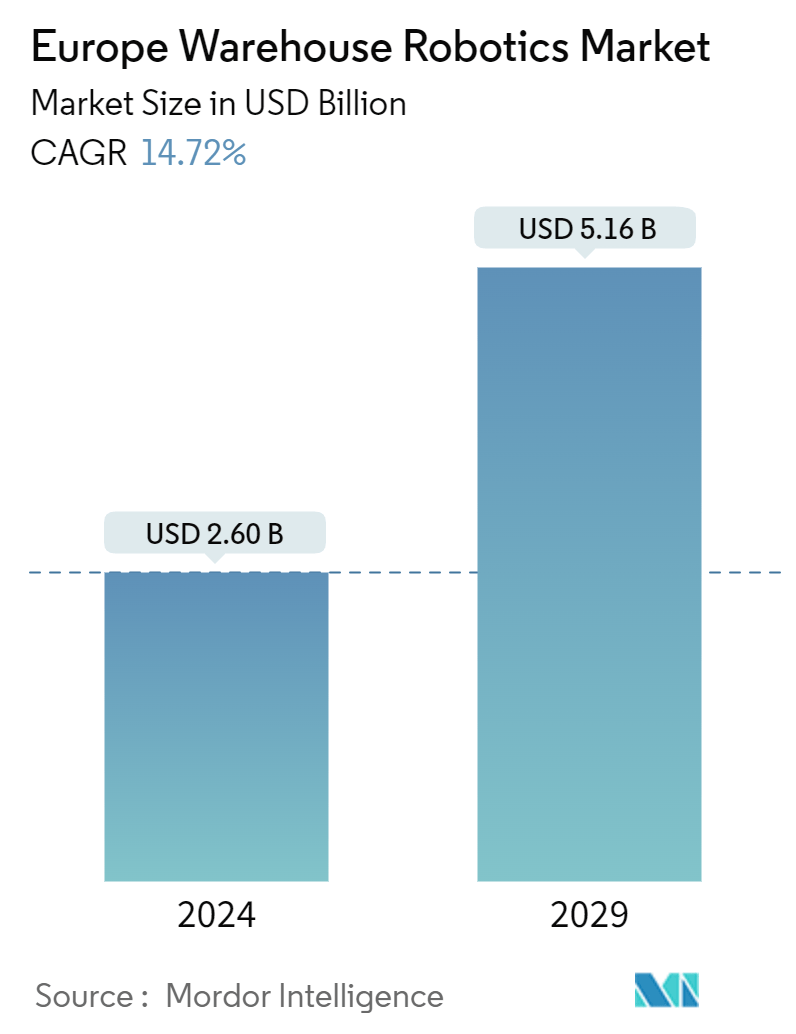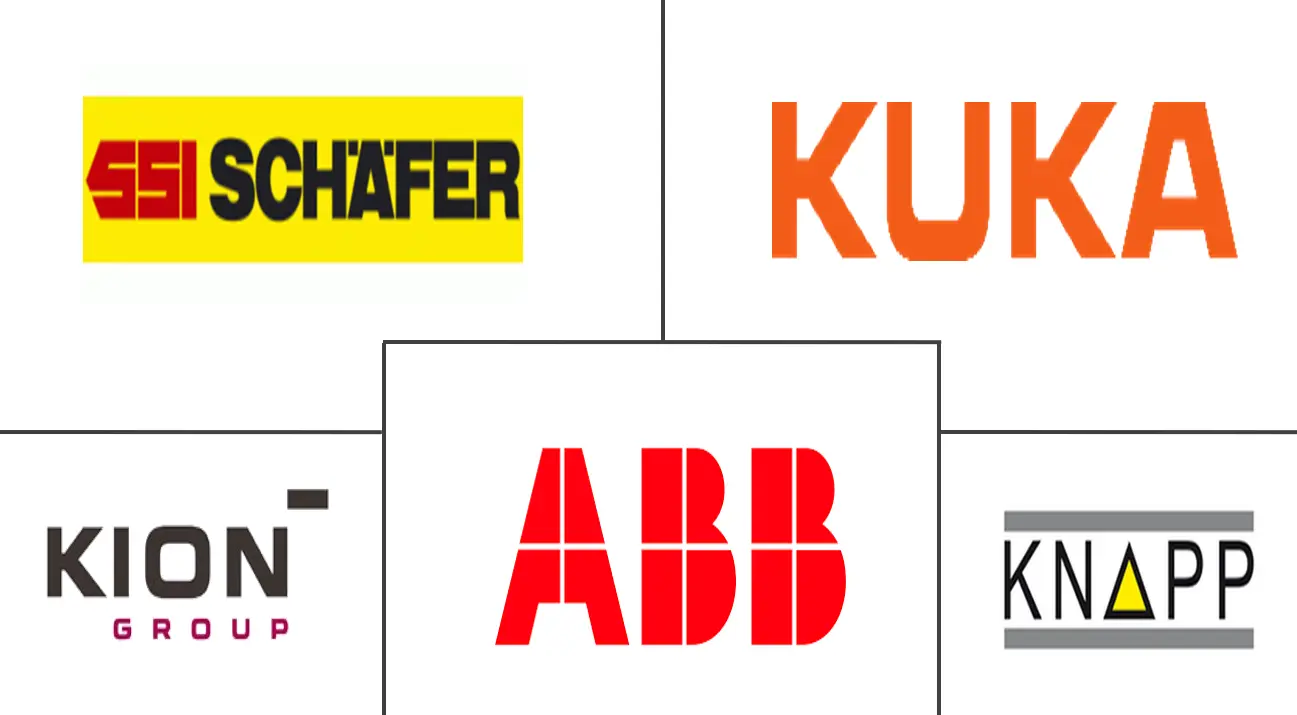Market Size of Europe Warehouse Robotics Industry

| Study Period | 2019 - 2029 |
| Base Year For Estimation | 2023 |
| Market Size (2024) | USD 2.60 Billion |
| Market Size (2029) | USD 5.16 Billion |
| CAGR (2024 - 2029) | 14.72 % |
| Market Concentration | High |
Major Players
*Disclaimer: Major Players sorted in no particular order |
Europe Warehouse Robotics Market Analysis
The Europe Warehouse Robotics Market size is estimated at USD 2.60 billion in 2024, and is expected to reach USD 5.16 billion by 2029, growing at a CAGR of 14.72% during the forecast period (2024-2029).
The growth of major industries, such as e-commerce, automotive, pharmaceutical, etc., in Europe and the growing awareness driving the need for efficient warehousing and inventory management are among the significant factors driving the studied market's growth.
- Automation in warehousing offers extreme convenience by reducing errors in product deliveries and business costs. According to DHL, a 3PL company and a significant end-user of warehouse automation solutions, assisted picking robots to represent a breakthrough in efficiency, increasing the number of items picked per hour by up to 180 percent. Such trends encourage vendors in the warehousing sector to increase their investment in automation and robotics.
- The rising number of warehouses and changing market demand and consumption patterns, coupled with the rise in labor costs and availability of scalable technology solutions in Europe, have driven the market for warehouse robots across European countries. For instance, according to Eurostat, the hourly labor costs in the Euro area rose by 4 percent in the euro area and by 4.4 percent in the European Union (EU) in the second quarter of 2022, compared with the same period of the previous year.
- Further, the emergence of the Industrial Internet of Things (IIoT) and the advent of a network of connected systems are helping industries perform a multitude of warehousing tasks, such as material batching, picking, ordering, packaging, warehouse security, and inspection, as well as improve the operational efficiency by huge margins. Such trends are also creating a favorable growth scenario for the studied market.
- Similar to the global trend, the e-commerce industry has also witnessed significant growth in the European region. The growing demand and trends such as instant/single-day delivery are positively impacting the studied market's development, making the e-commerce warehousing sector among the largest adopters of warehouse robots.
- Moreover, incremental advancement in technology, coupled with a sustained increase in the development of manufacturing facilities, is expected to impact the market growth rate during the forecast period.
- The market growth has been restricted by high costs, preventing mass adoption, especially in the small and medium warehouse segment. Also, the stringent regulatory requirement to use robots in the warehouse hinders market growth. However, the vendors in the market, such as Kuka Robotics, are not only providing robots for lease but have also launched a SmartFactory as a Service initiative to give their customers an option to rent out an entire robot-staffed automated plant.
Europe Warehouse Robotics Industry Segmentation
Warehouse robotics is the adoption of robotics in the warehouse that performs functions like storage, packaging, trans-shipment, and other functions. These robots work with full autonomy or in collaboration with operators to perform various tasks. The study comprehensively analyzes the trends, developments, and emerging opportunities in warehouse robotics to offer a detailed insight into the changing market dynamics.
The study segments the market by type (industrial robots, sortation systems, conveyors, palletizer, automated storage and retrieval systems(ASRS), mobile robots (AMR, and AGV)), by function (storage, packaging, trans-shipments, other functions), end-user application(food and beverage, automotive, retail, electrical and electronics, pharmaceutical, other end-users), and country (United Kingdom, Germany, France, Rest of Europe). The study also provides the impact analysis of COVID-19 on the market. The market sizes and forecasts are provided in terms of value (USD) for all the above segments.
| By Type | |
| Industrial Robots | |
| Sortation Systems | |
| Conveyors | |
| Palletizers | |
| Automated Storage and Retrieval System (ASRS) | |
| Mobile Robots (AGVs and AMRs) |
| By Function | |
| Storage | |
| Packaging | |
| Trans-shipments | |
| Other Functions |
| By End-user Application | |
| Food and Beverage | |
| Automotive | |
| Retail | |
| Electrical and Electronics | |
| Pharmaceutical | |
| Other End User Applications |
| ***By Country | |
| United Kingdom | |
| Germany | |
| France |
Europe Warehouse Robotics Market Size Summary
The European warehouse robotics market is experiencing significant growth, driven by the expansion of key industries such as e-commerce, automotive, and pharmaceuticals. The increasing demand for efficient warehousing and inventory management solutions is propelling the adoption of automation technologies across the region. The rise in labor costs and the availability of scalable technology solutions further contribute to the market's expansion. The integration of the Industrial Internet of Things (IIoT) is enhancing operational efficiencies by enabling connected systems to perform various warehousing tasks. This technological advancement is creating a favorable environment for the growth of warehouse robotics in Europe, with e-commerce being a major driver due to the demand for rapid delivery solutions.
Despite the promising growth prospects, the market faces challenges such as high initial costs and stringent regulatory requirements, which hinder widespread adoption, particularly among small and medium-sized warehouses. However, major players like ABB Ltd., KUKA AG, and SSI Schaefer AG are leading the market, focusing on strategic collaborations and technological innovations to expand their reach and enhance warehouse efficiency. The market is also witnessing new entrants and investments in advanced warehouse technologies, as seen with companies like Amazon and Maersk, which are actively investing in robotic solutions to streamline their supply chains. These trends indicate a robust growth trajectory for the European warehouse robotics market over the forecast period.
Europe Warehouse Robotics Market Size - Table of Contents
-
1. MARKET INSIGHTS
-
1.1 Market Overview
-
1.2 Industry Attractiveness - Porter's Five Forces Analysis
-
1.2.1 Bargaining Power of Suppliers
-
1.2.2 Bargaining Power of Buyers
-
1.2.3 Threat of New Entrants
-
1.2.4 Intensity of Competitive Rivalry
-
1.2.5 Threat of Substitute Products
-
-
1.3 Industry Value Chain Analysis
-
1.4 Impact of COVID-19 on the Market
-
-
2. MARKET SEGMENTATION
-
2.1 By Type
-
2.1.1 Industrial Robots
-
2.1.2 Sortation Systems
-
2.1.3 Conveyors
-
2.1.4 Palletizers
-
2.1.5 Automated Storage and Retrieval System (ASRS)
-
2.1.6 Mobile Robots (AGVs and AMRs)
-
-
2.2 By Function
-
2.2.1 Storage
-
2.2.2 Packaging
-
2.2.3 Trans-shipments
-
2.2.4 Other Functions
-
-
2.3 By End-user Application
-
2.3.1 Food and Beverage
-
2.3.2 Automotive
-
2.3.3 Retail
-
2.3.4 Electrical and Electronics
-
2.3.5 Pharmaceutical
-
2.3.6 Other End User Applications
-
-
2.4 ***By Country
-
2.4.1 United Kingdom
-
2.4.2 Germany
-
2.4.3 France
-
-
Europe Warehouse Robotics Market Size FAQs
How big is the Europe Warehouse Robotics Market?
The Europe Warehouse Robotics Market size is expected to reach USD 2.60 billion in 2024 and grow at a CAGR of 14.72% to reach USD 5.16 billion by 2029.
What is the current Europe Warehouse Robotics Market size?
In 2024, the Europe Warehouse Robotics Market size is expected to reach USD 2.60 billion.

